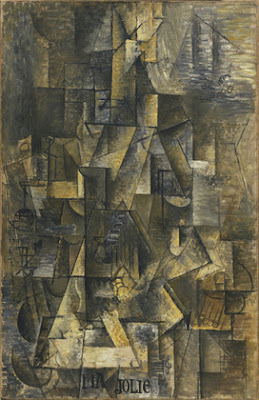Through literature, or the movies, we are accustomed to scenes in which a scientist or inventor, working in a lab or workshop, cobbles together some curiously shaped machine to perform some odious task, or concocts a mixture of foul smelling chemicals in creating a cure for cancer or teenage zits. Seldom do we realize that a roughly equivalent scene often takes place in the studios of hardworking artists as they solemnly work their way through the evolution of some landmark breakthrough in the understanding of painting, printmaking, or sculpture. Perhaps the discovery is not as earthshaking or beneficial to mankind as the discovery of polymers or the invention of incandescent light bulbs, but it is no less remarkable in that it may illuminate for artists to follow a whole new way of thinking or seeing or creating art.
 |
| Ma Jolie, 1911-12, Pablo Picasso |
During the years 1911-12, just such a scene was taking place daily in an isolated art studio located in the Montmartre section of Paris where two artists were studying together their recent "invention" of Cubism. They are legends by now--Pablo Picasso and Georges Braque. Together, they were moving art in directions never before seen or even imagined. Their work was so groundbreaking they were having to formulate a whole new lexicon just to discuss it among themselves and others. They were exploring the "metaphysical," wherein the subject of their work could no long be broken down into traditional classifications such as still-lifes, landscapes, or portraits. The subject matter was "art." The subject was light. The subject was space. The subject was lines, or planes, or process, or all of the above. Their work was becoming so esoteric even other artists had difficulty discussing it--like discussing nuclear physics with a matchmaker.
Harlequin, 1915, Pablo Picasso represents a mature synthetic cubism |
Picasso's 1912 painting Ma Jolie (Woman with a Zither or Guitar, above) was just such a breakthrough. Only the neatly lettered title at the bottom gives a clue as to the subject matter and even then one has to be privy to the mind of the master to gain any insight into what the painting is about. (It was a loving nickname he often used for his mistress at the time, Eva Gouel.) Like scientists splitting the atom for the first time, Picasso and Braque had pushed Cubism to the breaking point where even their recently coined term, Analytical Cubism was no longer applicable. From that point on in their work, something new emerged. No longer satisfied to merely analyze their subject matter volumetrically, they began to synthesize it, leading to their use of the term, "Synthetic Cubism" wherein the subject (or what little there was left of it) was viewed, analyzed, then synthesized. It was a new way of seeing art, thinking about art, and even producing an art in which oil paint on canvas alone was no longer adequate. Newspapers, wallpaper, glue, and eventually found objects were employed, blurring forever the lines between the physical and the metaphysical, painting and sculpture, illusion and reality.

Tidak ada komentar:
Posting Komentar